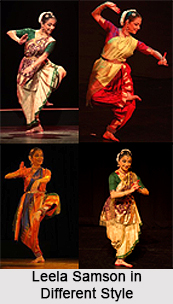 Leela Samson is a notable Bharatanatyam dancer, choreographer and writer from India. As a soloist, she has performed in various parts of India and abroad. Apart from this, she has taught Bharatanatyam at Shriram Bhartiya Kala Kendra in Delhi for many years. She was also the dance tutor of Priyanka Vadra. In 2005, she was appointed as the director of Kalakshetra by the Congress-led United Progressive Alliance. In 2010, she was appointed as the chairperson of the Sangeet Natak Akademi. In 2011, she was appointed as the chairperson of the Central Board of Film Certification.
Leela Samson is a notable Bharatanatyam dancer, choreographer and writer from India. As a soloist, she has performed in various parts of India and abroad. Apart from this, she has taught Bharatanatyam at Shriram Bhartiya Kala Kendra in Delhi for many years. She was also the dance tutor of Priyanka Vadra. In 2005, she was appointed as the director of Kalakshetra by the Congress-led United Progressive Alliance. In 2010, she was appointed as the chairperson of the Sangeet Natak Akademi. In 2011, she was appointed as the chairperson of the Central Board of Film Certification.
Early Life of Leela Samson
She was born on 6 May 1951 in Coonoor, Tamil Nadu to Vice-Admiral (Retd.) Benjamin Abraham Samson and Laila Samson. Her father belonged to the Jewish Bene-Israelite community from Pune, and her mother belonged to the Roman Catholic community from Ahmedabad. Her father was a lieutenant in the Royal Indian Navy and commandant of the National Defence Academy in Khadakvasla. At the age of nine, her father made her join Kalakshetra to learn Indian classical dance and music under the founder, Rukmini Devi Arundale. She completed her graduation in Bachelor of Arts.
Career of Leela Samson
Samson started her career as a Bharatanatyam soloist and performed across India and abroad including Europe, Africa and the Americas. She has taught Bharatanatyam across India and the world. In India, she has taught at Shriram Bharatiya Kala Kendra, Delhi, and Gandharva Mahavidyalaya, Delhi and in abroad, she has taught at the Royal Opera House, Covent Garden, London, and the annual Milapfest at Manchester. Samson has taught Bharatnatyam to Congress president Sonia Gandhi`s daughter Priyanka Vadra. Some of her well known disciples include the late Kamaljit Bhasin Maalik (Meeto), Jin Shan Shan (Eesha), Navtej Singh Johar and Anusha Subramanyam. Joyce Paul Poursabahian and Justin McCarthy, who now teaches at Sri Ram Bhartiya Kala Kendra are her other notable disciples.
In 1995, she formed a dance group named Spanda with the aim of reviewing the traditional vocabulary of Bharatanatyam. Two documentary films namely "Sanchari" and "The Flowering Tree" have been made on her works. She authored a biography of Rukmini Devi Arundale.
Achievements of Leela Samson
•She has received the Sanskriti, Nritya Choodamani, Kalaimamani in 2005 from the Government of Tamil Nadu.
•She has also received the Sangeet Natak Akademi Award (1999-2000) for her contributions to Bharatanatyam.
•She was honoured with the Padma Shri in 1990.



















